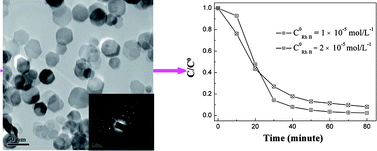Hexagonal tin disulfide nanoplatelets: A new photocatalyst driven by solar light†
Abstract
Single-crystalline, hexagonal

* Corresponding authors
a
College of Chemistry and Chemical Engineering, Anyang Normal University, Anyang, Henan, P. R. China
E-mail:
duweimin75@gmail.com
Tel: +86-372-2900040
b
School of Chemistry and Chemical Technology, State Key Laboratory of Metal Matrix Composites, Shanghai Jiao Tong UniVersity, Shanghai, P. R. China
E-mail:
xfqian@sjtu.edu.cn
Fax: +86-21-5474-1297
Tel: +86-21-5474-3262
Single-crystalline, hexagonal

 Please wait while we load your content...
Something went wrong. Try again?
Please wait while we load your content...
Something went wrong. Try again?
W. Du, D. Deng, Z. Han, W. Xiao, C. Bian and X. Qian, CrystEngComm, 2011, 13, 2071 DOI: 10.1039/C0CE00596G
To request permission to reproduce material from this article, please go to the Copyright Clearance Center request page.
If you are an author contributing to an RSC publication, you do not need to request permission provided correct acknowledgement is given.
If you are the author of this article, you do not need to request permission to reproduce figures and diagrams provided correct acknowledgement is given. If you want to reproduce the whole article in a third-party publication (excluding your thesis/dissertation for which permission is not required) please go to the Copyright Clearance Center request page.
Read more about how to correctly acknowledge RSC content.
 Fetching data from CrossRef.
Fetching data from CrossRef.
This may take some time to load.
Loading related content
